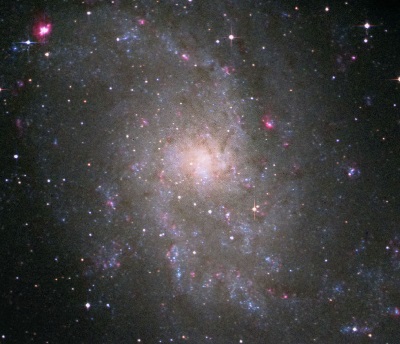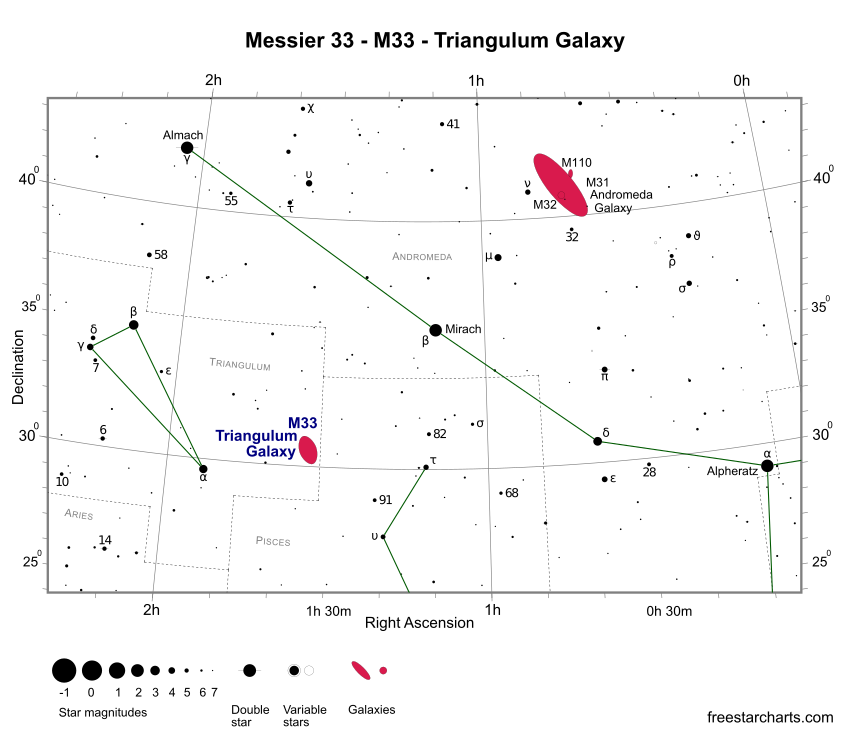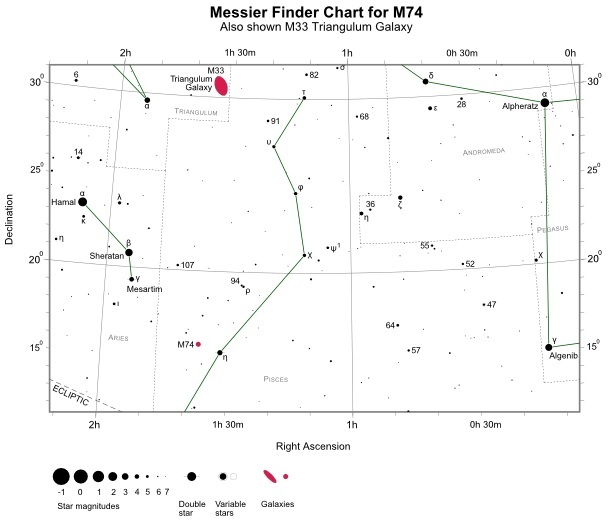M33, also known as the Triangulum Galaxy or Pinwheel Galaxy, is a spiral galaxy in the constellation Triangulum, that's located at a distance of approximately 2.81 million light-years. It's the third largest member of the Local Group, which also includes our Milky Way galaxy, the Andromeda Galaxy (M31) and at least 50 other smaller galaxies.
A magnitude +5.7, M33 can be viewed with the naked eye from a dark site and is widely regarded as the most distant permanent object that can be seen without optical aid. There are rare reports that some eagle-eyed stargazers have managed, under exceptional conditions, to spot more distance M81 but that's incredible viewing by all respects.
M33 was probably discovered by Italian astronomer Giovanni Battista Hodierna before 1654. He listed it in his work regarding cometary orbits and admirable objects of the sky. Charles Messier independently re-discovered the galaxy on the night of August 25, 1764.
A good starting point to locate M33 is the Great Square of Pegasus. Start by focusing on its northeastern star Alpheratz (α And - mag. +2.1). Although it lies at one corner of the square, Alpheratz is officially designated as belonging to Andromeda. Next move 15 degrees northeast to red-giant star Mirach (β And). At mag. +2.1, Mirach is the same brightness as Alpheratz. Then imagine a line from Mirach moving in a southeasterly direction for 11 degrees until you reach alpha Tri (α Tri - mag. +3.4). This is the southernmost star of the Triangulum triangle and just over halfway along this line is M33.
The galaxy is best seen from Northern Hemisphere locations during the months of October, November and December.


Finder Chart for M33 - pdf format (credit:- freestarcharts)

Finder Chart for M74 (also shown M33) - pdf format (credit:- freestarcharts)
Despite being visible to the naked eye from a dark site, the Triangulum Galaxy is often regarded as an elusive object. It appears face-on from our perspective and although large and covering more than a degree of sky (71 x 42 arc minutes), it suffers from a low surface brightness. As a result, even a small amount of light pollution can render it invisible.
However, it's a different story under dark skies. Binoculars reveal a large mist without detail. An 80mm (3.1-inch) scope shows the galaxy as a very large diffuse patch of light, covering much of the field of view with a slightly brighter centre that's best viewed using low powers. A medium size 150mm (6-inch) or 200mm (8-inch) scope enhances the core and brings out some mottling. A larger telescope of at least 300mm (12-inch) aperture is required to reveal the spiral structure, along with dark dust lanes, knotty patches of nebulosity and other subtle features. For the budding astrophotographer, M33 is a rewarding target with the spiral arms and brighter nebulae relatively easy to capture.
Overall, M33 has a diameter of about 60,000 light-years and is estimated to contain 40 billion stars. For comparison, the Milky Way contains 400 billion stars and M31 about 1 trillion (1,000 billion).
M33 Data Table
| Messier | 33 |
|---|---|
| NGC | 598 |
| Name | Triangulum galaxy |
| Object Type | Spiral galaxy |
| Classification | SA(s)cd |
| Constellation | Triangulum |
| Distance (light-years) | 2.81 Million |
| Apparent Mag. | +5.7 |
| RA (J2000) | 01h 33m 51s |
| DEC (J2000) | +30d 39m 37s |
| Apparent Size (arc mins) | 71 x 42 |
| Radius (light-years) | 30,000 |
| Number of Stars | 40 Billion |
| Other Name | Pinwheel galaxy |